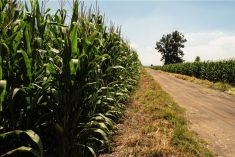Washington | Reuters — U.S. farmers will cut their plantings of both soybeans and corn this spring with supplies of both commodities at record highs, the U.S. Agriculture Department said on Thursday.
Soybean plantings, despite the expected drop, will top corn acreage for the first time since 1983, USDA said.
Wheat seedings will rise by three per cent, according to the government’s annual prospective plantings report, which is based on surveys of nearly 83,000 farmers during the first two weeks of March.
Corn and soybean futures jumped sharply after the report was released, with both hitting their highest since mid-March.
Read Also

U.S. grains: Soy futures post biggest monthly gain in nearly five years on China trade optimism
U.S. soybean futures climbed to a 15-month high and posted their biggest monthly gain in nearly five years on Friday following a rally fueled by the prospect of revived exports to China.
“Obviously it’s a big shock to the market,” said Jack Scoville, analyst at The Price Futures Group.
The government said soybean acreage will total 88.982 million in 2018, down from 90.142 million acres a year ago. Analysts’ forecasts for soybean acreage ranged from 89.9 million to 92.6 million, according to a Reuters survey.
U.S. soybean supplies as of March 1 totaled 2.107 billion bushels, up 21 per cent from a year earlier and the most ever for the period, USDA said in its quarterly stocks report. That was near the high end of market forecasts.
Soybean stocks were on the rise as China, the world’s largest soy importer, has focused on Brazilian supplies to meet its needs because the massive crop harvested by U.S. farmers in 2017 had low protein content.
USDA predicted that corn acreage will drop to 88.026 million acres from 90.167 million a year ago, near the low end of analysts’ estimates that ranged from 87.55 million acres to 91 million.
U.S. corn stocks as of March 1 stood at 8.888 billion bushels, up from 8.622 billion bushels a year earlier and also a record for the period. The stocks figure topped analysts’ expectations.
Wheat seedings were predicted to rise to 47.339 million acres from 46.012 million a year ago. That compares with analysts’ forecasts for 43.9 million to 47.2 million wheat acres.
USDA forecast that farmers will boost their winter wheat seedings and spring wheat (other than durum) seedings. Durum acreage was seen falling 13.1 per cent from 2017.
Wheat stocks as of March 1 fell to 1.494 billion bushels from 1.659 billion bushels a year earlier. Analysts had been expecting wheat stocks of 1.498 billion bushels, according to the average of estimates in a Reuters survey.
— Mark Weinraub is a Reuters commodities correspondent based in Chicago; additional reporting by Michael Hirtzer in Chicago.











